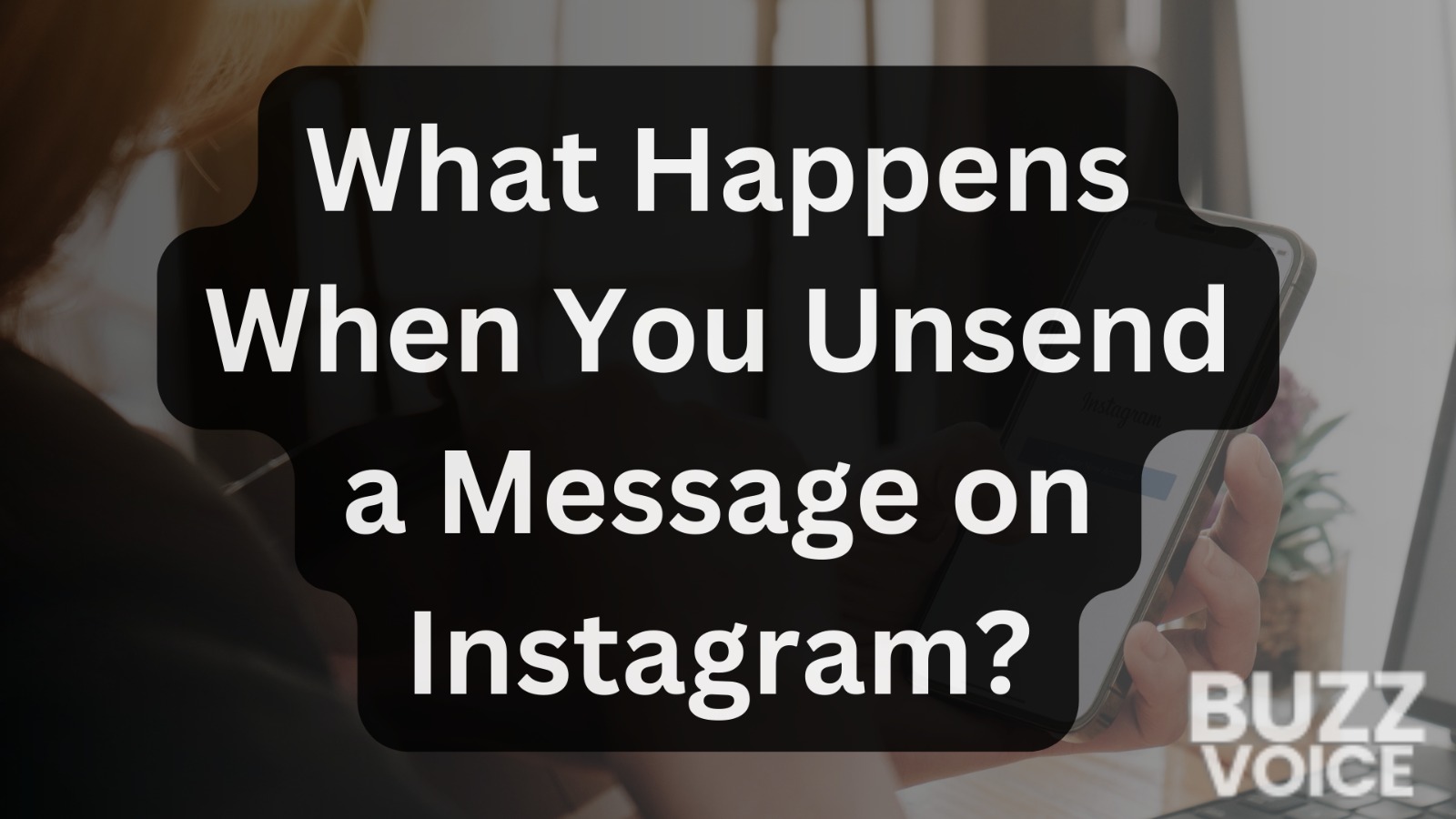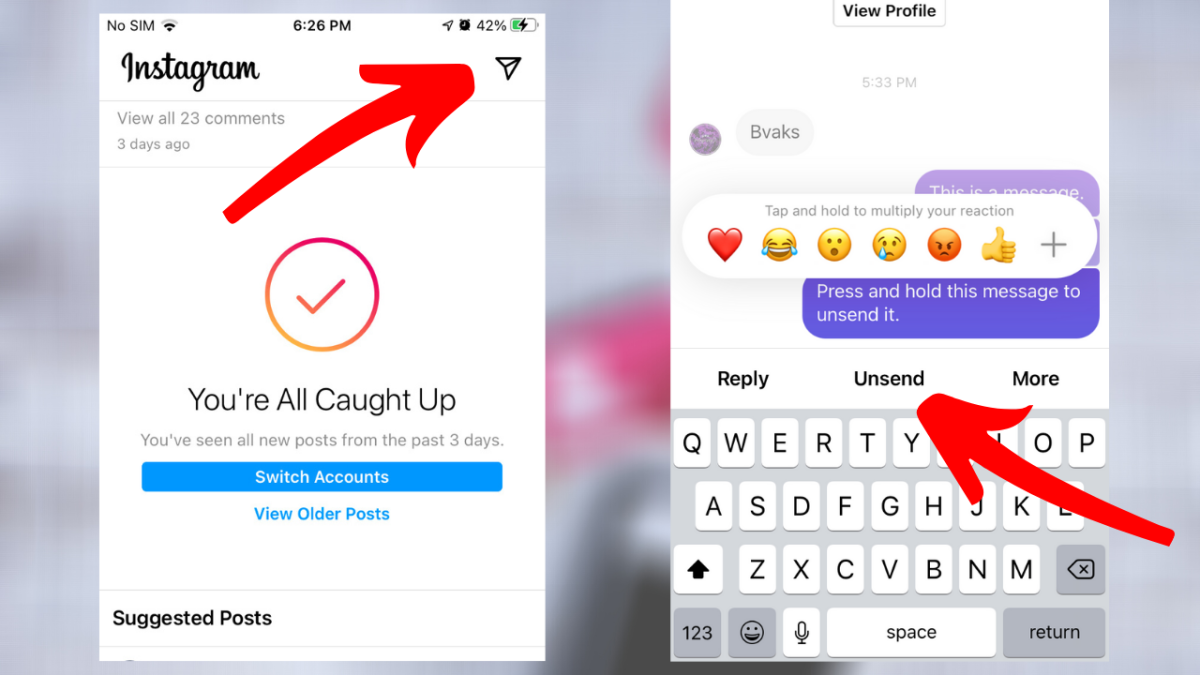So, youve sent a message on Instagram and immediately regretted it? You're not alone. The ability to "unsend" a message on Instagram has become a lifeline for many, a digital do-over button that offers a chance to erase a hasty word, a misinterpreted joke, or a private revelation intended for a different audience. But what exactly happens when you hit that deceptively simple "unsend" button? Does it truly vanish into the digital ether, or does a trace remain? The answer, as with most things in the complex world of social media, is nuanced and worth exploring.
The mechanics of unsending are straightforward, at least on the surface. A user, upon realizing a mistake, can long-press the offending message within a direct message (DM) thread and select the "unsend" option. This action removes the message from both their own inbox and, in theory, the recipient's inbox as well. The message is replaced with a simple notification: "You unsent a message." It's a clean, efficient, and seemingly effective way to rectify a momentary lapse in judgment. But the digital world is rarely as simple as it seems. There are several layers of complexity in understanding the complete consequences of unsending a message, some of which might surprise even the most seasoned social media users.
Before delving into the details of what happens "behind the scenes," consider this hypothetical scenario: Sarah accidentally sends a message to her boss, Mark, that was clearly intended for her friend, expressing her frustrations about a recent project. Horrified, she immediately hits "unsend." Mark sees the notification that she unsent a message. Does he immediately forget about the awkward exchange? Does he assume it was important? What would his response be? These are the types of questions the feature poses and their impact, if any.
To further understand the implications of unsending, let's break down the technical aspects. The unsend feature, first implemented in 2018, was a significant step in empowering users to control their digital footprint. Prior to this, deleting messages within your own inbox didn't remove them from the recipient's view. This new functionality, while valuable, has limitations, which must be considered before deploying this function.
Here's a breakdown of the main points:
- Removal from the Recipient's View: The primary function of unsending is to remove the message from the recipient's inbox. As long as the recipient hasn't read the message, it will disappear from their view entirely.
- Notification of Unsending: Instagram provides a notification to the recipient indicating that a message has been unsent. This notification serves as a signal that something was there, potentially raising curiosity or suspicion. This is essential for understanding the full impact of the feature.
- Limitations with Notifications: If the recipient has already received a notification of the message before it's unsent, that notification remains on their device. This is a crucial detail; the initial notification provides a lasting impact, even if the message is then unread.
- Recipient Reading the Message: If the recipient has already viewed the message before it's unsent, they have the opportunity to see the content, even if the message is later removed from the conversation. The window of time where unsending is effective is therefore shortened.
- Third-Party Apps and Data Recovery: There are claims, though generally unsubstantiated, that certain third-party applications might be able to access or recover unsent messages. While the official Instagram app is the primary source of information, the possibility that external applications could access this data cannot be completely ruled out.
- Reporting and Screenshots: Even after a message is unsent, the recipient can report the user to Instagram and include screenshots. This is a critical factor; it is a workaround for the unsend feature and can potentially still lead to account repercussions if the content violates Instagram's community guidelines.
Let's explore the details of the main factors.
The Recipient's Perspective: The Curious Case of the "Unsent Message" Notification
The notification "You unsent a message" is perhaps the most fascinating aspect of the unsend feature. It's a digital breadcrumb, leaving a trace of the sender's action while simultaneously obscuring the original content. From the recipient's perspective, the notification can trigger a cascade of thoughts and emotions. Curiosity is often the dominant reaction; the recipient may wonder what was said, why it was unsent, and whether the context was something to be concerned about. This notification can generate social friction and fuel more conflict than it defuses.
Beyond mere curiosity, the notification can also create suspicion. It may indicate a possible mistake, a misjudgment on the sender's part, or even deliberate deception. In some scenarios, the notification of an unsent message could even be interpreted as a sign of disrespect or an act of aggression, potentially leading to conflict or misunderstandings. The context of the relationship between the sender and the recipient plays a significant role in how the notification is perceived; a friendly message unsent to a friend is viewed differently from a critical message removed from a professional contact.
Another crucial element in the recipient's experience is their awareness of their privacy. Many people who frequently communicate on Instagram are highly conscious of their privacy and data. For them, the unsend feature, while offering a layer of control, also highlights the inherent limitations of privacy in the digital world. The lingering "You unsent a message" notification is a stark reminder that the sender can, and often does, control what is shared, further emphasizing the need for caution and mindful communication.
Technical Aspects: Understanding the Data Trail
From a technical point of view, the mechanics of the unsend feature are more complex. Instagram, like all social media platforms, stores data about user interactions. When a message is sent, a record is created, containing information about the sender, the recipient, the timestamp, and the message content. When a message is unsent, this record is updated rather than deleted entirely. This means that the initial data, including the original message, might still exist on Instagram's servers even after it's been removed from the user's view. The extent to which this data is retained and accessible is unclear.
Instagram claims to delete the message from both parties' inboxes. This likely entails removing the message from the active display within the chat thread. However, the underlying data may be kept for a certain period, usually for reasons related to data analysis, security, and compliance with legal requirements. The precise details of these data retention policies are often guarded, but it's safe to assume that some form of record keeping persists for a defined timeframe.
There are also concerns about data breaches and potential vulnerabilities within the platform. If Instagram were to experience a security breach, the data related to unsent messages might be exposed, providing access to content that was intended to be erased. The security of the platform is a continuously evolving landscape, and therefore, the security and integrity of deleted content are not guaranteed. This is why users must be mindful of the level of trust they place in any social media platform.
The Impact on Relationships: Navigating the Social Minefield
The unsend feature can have significant implications on the dynamics of interpersonal relationships. In casual interactions, the ability to correct a mistake can be a welcome feature. However, in more important interactions, where trust and openness are essential, the unsend feature can create a climate of uncertainty and suspicion. If the unsend feature is used too often, it can undermine the sense of connection between users.
For example, in a romantic relationship, if a partner repeatedly unsends messages, this can erode trust and lead to feelings of insecurity. The constant uncertainty about what was said and why it was removed can create emotional distance and communication barriers. A similar dynamic can emerge in professional relationships. If a colleague unsends a message after a disagreement, it can be perceived as a lack of commitment to open communication, potentially harming the professional relationship.
The context of the relationship is crucial when assessing the impact of the unsend feature. In some relationships, unsending a message may be understood, whereas in others, it could have more serious repercussions. If a user sends a message that is unintentionally hurtful or offensive, an apology, followed by open communication, could be more effective than simply unsending the message.
Legal and Ethical Considerations: Beyond the "Unsend" Button
The unsend feature raises some legal and ethical questions that deserve consideration. While the feature is designed to offer users a level of control over their messages, it does not absolve them from legal or ethical responsibilities. Messages are part of the user's digital footprint. A message that has been unsent may still be accessible in specific circumstances. This makes it essential to consider the potential legal consequences of a message before sending it.
For example, in cases of defamation or harassment, a message that has been unsent could still be used as evidence in a legal dispute. The recipient of the message could have taken a screenshot before it was unsent, or a third party might have a copy of the message. In such scenarios, the unsend feature provides no protection against legal repercussions. It is crucial that users understand the legal ramifications of their communications, even when they believe that they have erased a message.
Ethically, the use of the unsend feature can be viewed in different ways. Some people consider it a positive feature that allows for correcting mistakes and reducing the impact of miscommunications. Others view it as an attempt to rewrite history, which can undermine trust and transparency. The ethical implications of the unsend feature vary depending on the context of the communication, the relationship between the sender and the recipient, and the content of the message.
Best Practices: Using the Unsend Feature Responsibly
To maximize the benefits of the unsend feature while minimizing potential negative impacts, consider these best practices:
- Think Before You Send: The best way to avoid regretting a message is to think carefully before pressing "send." Review the message content, consider the intended audience, and ensure your tone is appropriate for the relationship.
- Use with Caution: The unsend feature should be used sparingly. Frequent use can erode trust and make recipients skeptical.
- Acknowledge and Apologize: If you've sent a message that requires unsending, consider acknowledging your mistake and apologizing to the recipient. This demonstrates accountability and can repair potential damage.
- Consider the Alternatives: Before unsending a message, consider other options, such as editing the message or following up with a phone call.
- Respect Privacy: Always respect the privacy of the recipient. Avoid sending messages that contain sensitive or confidential information.
- Be Transparent: If you unsend a message, it's often better to be upfront about it, explaining the reason.
Conclusion: Navigating the Digital Aftermath
The "unsend" feature on Instagram offers users a potent tool for managing their digital communications, providing a valuable option for correcting errors and mitigating potential misunderstandings. Yet, the implications of unsending go far beyond the simple act of deleting a message. The recipient's perception, technical complexities, the impact on relationships, and legal/ethical implications are all vital factors to consider. Being aware of these intricacies can empower users to make informed decisions when using the unsend feature, cultivating more mindful communication in the digital age.
The feature is not a get-out-of-jail-free card. The user still bears responsibility for the content they send. The user's digital footprint is complex, and there is no guarantee that the message will disappear completely. Using the unsend feature is not a license to say anything without consequences. Users must approach it with awareness, care, and respect for others.
Remember that the digital world is interconnected, and every action leaves a mark. Use the "unsend" feature with care, and always prioritize thoughtful, considerate communication.



